初中英语写作课教学案例
初中英语课本写作教案
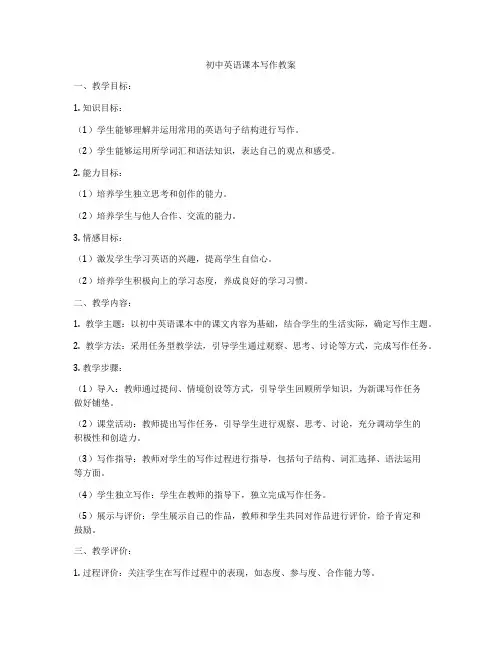
初中英语课本写作教案一、教学目标:1. 知识目标:(1)学生能够理解并运用常用的英语句子结构进行写作。
(2)学生能够运用所学词汇和语法知识,表达自己的观点和感受。
2. 能力目标:(1)培养学生独立思考和创作的能力。
(2)培养学生与他人合作、交流的能力。
3. 情感目标:(1)激发学生学习英语的兴趣,提高学生自信心。
(2)培养学生积极向上的学习态度,养成良好的学习习惯。
二、教学内容:1. 教学主题:以初中英语课本中的课文内容为基础,结合学生的生活实际,确定写作主题。
2. 教学方法:采用任务型教学法,引导学生通过观察、思考、讨论等方式,完成写作任务。
3. 教学步骤:(1)导入:教师通过提问、情境创设等方式,引导学生回顾所学知识,为新课写作任务做好铺垫。
(2)课堂活动:教师提出写作任务,引导学生进行观察、思考、讨论,充分调动学生的积极性和创造力。
(3)写作指导:教师对学生的写作过程进行指导,包括句子结构、词汇选择、语法运用等方面。
(4)学生独立写作:学生在教师的指导下,独立完成写作任务。
(5)展示与评价:学生展示自己的作品,教师和学生共同对作品进行评价,给予肯定和鼓励。
三、教学评价:1. 过程评价:关注学生在写作过程中的表现,如态度、参与度、合作能力等。
2. 成果评价:评价学生写作作品的质量,如内容完整性、语言准确性、创意性等。
3. 情感评价:关注学生在学习过程中的情感变化,如兴趣、自信心、学习动力等。
四、教学资源:1. 教材:初中英语课本。
2. 辅助材料:相关写作话题的图片、视频、文章等。
3. 教学设备:投影仪、电脑、黑板等。
五、教学建议:1. 注重培养学生的语言基础,提高学生的词汇量和语法水平。
2. 鼓励学生多阅读,拓宽视野,积累写作素材。
3. 教师应给予学生足够的关爱和支持,关注学生个体差异,调整教学策略。
4. 创设良好的学习氛围,让学生在轻松愉快的环境中学习英语。
5. 定期进行写作训练,提高学生的写作能力。
初中英语作文教案

初中英语作文教案一、教学目标:1.能够掌握基本的英语作文写作技巧;2.能够运用所学知识,写出简单、连贯、有逻辑的英语作文;3.培养学生的英语写作兴趣,提高写作能力。
二、教学重点:1.培养学生的写作兴趣;2.教授基本的英语写作技巧;3.激发学生的写作创造力。
三、教学难点:1.如何培养学生的写作兴趣;2.如何激发学生的写作创造力。
四、教学内容:1.教师引导学生阅读范文,分析范文结构、语言表达等;2.教师讲解英语作文写作技巧,如句型搭配、词汇运用等;3.教师指导学生进行写作训练,如写作练习、写作指导等;4.教师布置作业,让学生在家继续练习写作。
五、教学过程:1.教师引导学生阅读范文,分析范文结构、语言表达等,激发学生的写作兴趣;2.教师讲解英语作文写作技巧,如句型搭配、词汇运用等,提高学生的写作能力;3.教师指导学生进行写作训练,如写作练习、写作指导等,培养学生的写作技能;4.教师布置作业,让学生在家继续练习写作,巩固所学知识。
六、教学方法:1.导入法,通过引导学生阅读范文,激发学生的写作兴趣;2.讲授法,通过讲解英语作文写作技巧,提高学生的写作能力;3.示范法,通过指导学生进行写作训练,培养学生的写作技能;4.作业法,通过布置作业,巩固所学知识,提高学生的写作水平。
七、教学手段:1.多媒体课件,用于展示范文、写作技巧等;2.教学实物,如英语作文书籍、写作范文等;3.黑板报,用于记录重点、难点内容,帮助学生复习。
八、教学检查与评价:1.教师在课堂上进行实时检查,发现学生写作中的问题并及时纠正;2.教师在课后进行作业批改,对学生的写作进行评价,指导学生改进。
九、教学反思:1.教师要及时调整教学方法,根据学生的实际情况进行针对性教学;2.教师要注重培养学生的写作兴趣,激发学生的写作热情;3.教师要关注学生的写作能力提高情况,及时进行评价和指导。
初中英语作文教案到此结束,希望本教案能够帮助到广大英语教师,提高学生的写作水平。
初中英语人教版九年级全册Unit9WritingMyFavoriteMusic优秀教学案例
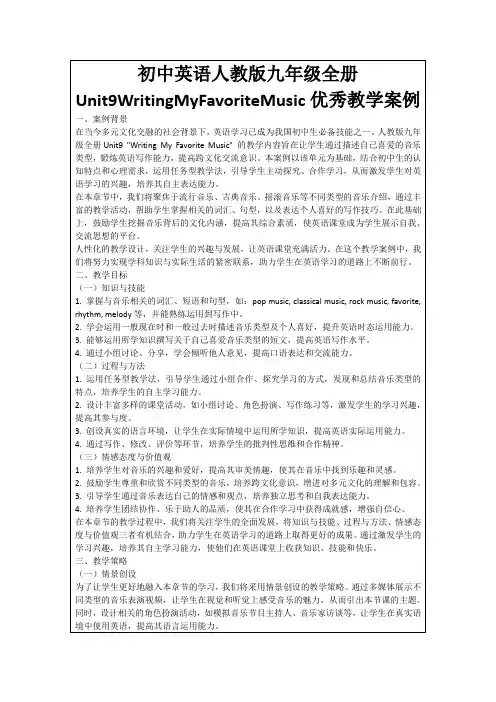
4.通过小组讨论、分享,学会倾听他人意见,提高口语表达和交流能力。
(二)过程与方法
1.运用任务型教学法,引导学生通过小组合作、探究学习的方式,发现和总结音乐类型的特点,培养学生的自主学习能力。
2.设计丰富多样的课堂活动,如小组讨论、角色扮演、写作练习等,激发学生的学习兴趣,提高其参与度。
五、案例亮点
1.真实语境的情景创设
本教学案例通过展示不同类型的音乐表演视频,让学生在真实语境中感受音乐的魅力,激发学习兴趣。情景创设使学生在轻松愉快的氛围中学习英语,提高语言运用能力,体现了以学生为主体的教学理念。
2.问题导向的探究学习
本案例以问题为导向,引导学生思考音乐类型的特点及其对个人喜好产生的影响。学生在解答问题的过程中,主动发现和总结知识,培养批判性思维和自主学习能力。
5.知识与情感态度的有机结合
本案例不仅注重英语知识与技能的培养,还关注学生情感态度与价值观的塑造。通过学习不同类型的音乐,引导学生尊重和欣赏多元文化,培养跨文化意识,提升审美情趣。
3.引导学生通过音乐表达自己的情感和观点,培养独立思考和自我表达能力。
4.培养学生团结协作、乐于助人的品质,使其在合作学习中获得成就感,增强自信心。
在本章节的教学过程中,我们将关注学生的全面发展,将知识与技能、过程与方法、情感态度与价值观三者有机结合,助力学生在英语学习的道路上取得更好的成果。通过激发学生的学习兴趣,培养其自主学习能力,使他们在英语课堂上收获知识、技能和快乐。
3.小组合作促进互动交流
案例中,学生分组研究不同类型的音乐,共同完成写作任务。这种小组合作的学习方式,有助于培养学生团结协作、乐于助人的品质,提高学生的沟通能力和团队意识。
初一上英语写作课教案
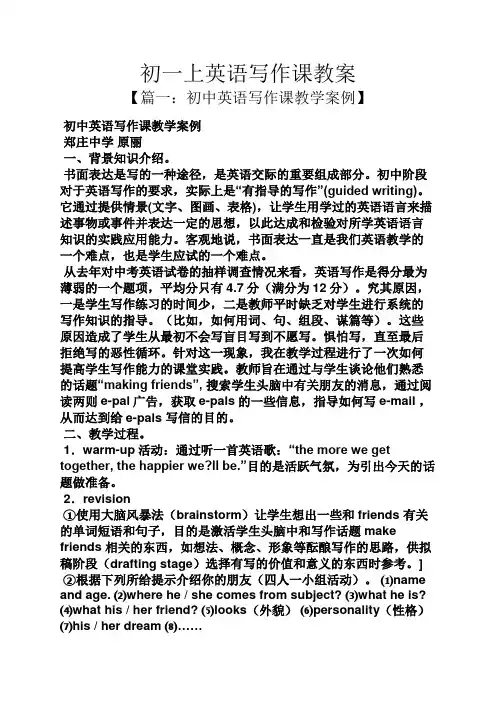
初一上英语写作课教案【篇一:初中英语写作课教学案例】初中英语写作课教学案例郑庄中学原丽一、背景知识介绍。
书面表达是写的一种途径,是英语交际的重要组成部分。
初中阶段对于英语写作的要求,实际上是“有指导的写作”(guided writing)。
它通过提供情景(文字、图画、表格),让学生用学过的英语语言来描述事物或事件并表达一定的思想,以此达成和检验对所学英语语言知识的实践应用能力。
客观地说,书面表达一直是我们英语教学的一个难点,也是学生应试的一个难点。
从去年对中考英语试卷的抽样调查情况来看,英语写作是得分最为薄弱的一个题项,平均分只有4.7分(满分为12分)。
究其原因,一是学生写作练习的时间少,二是教师平时缺乏对学生进行系统的写作知识的指导。
(比如,如何用词、句、组段、谋篇等)。
这些原因造成了学生从最初不会写盲目写到不愿写。
惧怕写,直至最后拒绝写的恶性循环。
针对这一现象,我在教学过程进行了一次如何提高学生写作能力的课堂实践。
教师旨在通过与学生谈论他们熟悉的话题“making friends”, 搜索学生头脑中有关朋友的消息,通过阅读两则e-pal广告,获取e-pals的一些信息,指导如何写e-mail ,从而达到给e-pals 写信的目的。
二、教学过程。
1.warm-up活动:通过听一首英语歌:“the more we get together, the happier we?ll be.”目的是活跃气氛,为引出今天的话题做准备。
2.revision①使用大脑风暴法(brainstorm)让学生想出一些和friends 有关的单词短语和句子,目的是激活学生头脑中和写作话题make friends 相关的东西,如想法、概念、形象等酝酿写作的思路,供拟稿阶段(drafting stage)选择有写的价值和意义的东西时参考。
]②根据下列所给提示介绍你的朋友(四人一小组活动)。
⑴name and age. ⑵where he / she comes from subject? ⑶what he is?⑷what his / her friend? ⑸looks(外貌)⑹personality(性格)⑺his / her dream ⑻……3.pre-reading 通过提问,how can you know your friends, if you haven?t seen each other for a long time? 联系朋友有很多方法,但是 one of the best ways is sending e-mails to them. do you know why?过渡今天话题的材料,快速看完两则e-pal广告,找出答案。
英语教学案例分析范文6篇初中
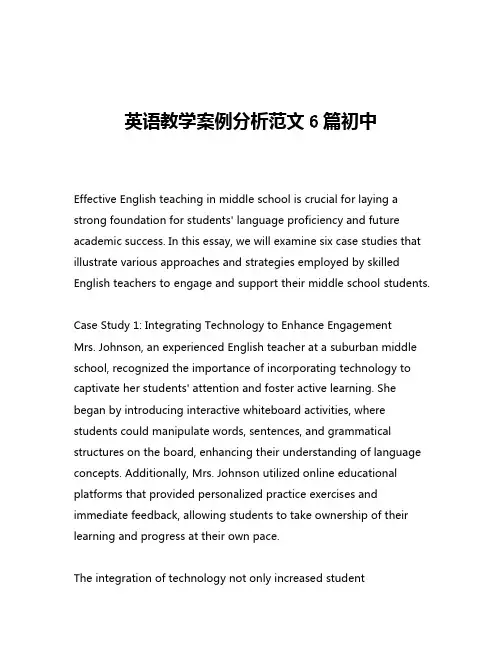
英语教学案例分析范文6篇初中Effective English teaching in middle school is crucial for laying a strong foundation for students' language proficiency and future academic success. In this essay, we will examine six case studies that illustrate various approaches and strategies employed by skilled English teachers to engage and support their middle school students.Case Study 1: Integrating Technology to Enhance Engagement Mrs. Johnson, an experienced English teacher at a suburban middle school, recognized the importance of incorporating technology to captivate her students' attention and foster active learning. She began by introducing interactive whiteboard activities, where students could manipulate words, sentences, and grammatical structures on the board, enhancing their understanding of language concepts. Additionally, Mrs. Johnson utilized online educational platforms that provided personalized practice exercises and immediate feedback, allowing students to take ownership of their learning and progress at their own pace.The integration of technology not only increased studentengagement but also enabled Mrs. Johnson to differentiate instruction and cater to diverse learning styles. Students who struggled with traditional pen-and-paper exercises found the digital activities more appealing and accessible, while those who thrived on independent learning benefited from the self-paced nature of the online resources. The result was a more dynamic and inclusive classroom environment, where all students felt empowered to participate and succeed in their English studies.Case Study 2: Fostering Critical Thinking through Literature Circles Mr. Patel, a middle school English teacher in a diverse urban setting, recognized the importance of developing his students' critical thinking skills. He implemented a literature circles approach, where students were divided into small groups and assigned different roles, such as discussion leader, connector, and literary analyst. Each group was responsible for reading a selected work of literature and engaging in collaborative discussions to unpack the themes, characters, and literary devices.The literature circles not only encouraged active engagement with the text but also cultivated essential communication and problem-solving skills. Students learned to listen actively, express their ideas clearly, and consider multiple perspectives. Mr. Patel's role shifted from a traditional lecturer to a facilitator, guiding the discussions and prompting students to delve deeper into the literary analysis.The success of this approach was evident in the students' increased confidence in expressing their interpretations and the depth of their literary analysis. Additionally, the collaborative nature of the literature circles fostered a sense of community and camaraderie among the students, further enhancing their overall learning experience.Case Study 3: Integrating Authentic Cultural ExperiencesIn a middle school with a growing population of English language learners, Ms. Garcia recognized the importance of incorporating authentic cultural experiences into her English lessons. She collaborated with the school's diversity committee to organize cultural celebrations and invite guest speakers from various backgrounds to share their stories and traditions.During these events, students had the opportunity to engage with the English language in a meaningful and contextual manner. They learned vocabulary and expressions related to the featured cultures, participated in interactive activities, and gained a deeper appreciation for the diversity within their school community. The cultural experiences also served as a platform for students to practice their speaking and listening skills in a low-stress, authentic setting.The integration of authentic cultural experiences not only improvedthe English language proficiency of the English language learners but also fostered a greater sense of inclusion and understanding among all students. The cross-cultural exchange and exposure to diverse perspectives enriched the learning environment and contributed to the overall growth and development of the students.Case Study 4: Differentiated Instruction for Struggling Readers Mrs. Nguyen, a middle school English teacher in a high-needs district, recognized the diverse learning needs of her students, particularly those who struggled with reading comprehension. She implemented a multi-tiered system of support, where she provided targeted interventions and differentiated instruction to address the individual needs of her students.For students who required additional support, Mrs. Nguyen utilized research-based reading strategies, such as guided reading, vocabulary development, and explicit instruction in phonics and fluency. She also incorporated the use of audiobooks, text-to-speech software, and graphic organizers to help struggling readers access the content and actively engage with the material.Mrs. Nguyen's dedication to differentiated instruction paid off, as her struggling readers demonstrated significant improvements in their reading abilities and overall academic performance. The individualized attention and tailored support not only boosted theirconfidence but also instilled a love for reading and learning.Case Study 5: Integrating Project-Based LearningMr. Goldstein, a middle school English teacher in a suburban setting, recognized the importance of making the English curriculum more relevant and engaging for his students. He implemented a project-based learning approach, where students were tasked with creating multimedia presentations on topics of their choice, ranging from social issues to literary analyses.The project-based learning approach allowed students to take an active role in their learning, as they conducted research, synthesized information, and utilized various technological tools to present their findings. Mr. Goldstein provided guidance and feedback throughout the process, ensuring that students developed essential skills, such as critical thinking, problem-solving, and effective communication.The project-based learning activities not only enhanced the students' engagement and motivation but also fostered their ability to collaborate, think creatively, and apply their knowledge to real-world situations. The final presentations showcased the students' diverse talents and perspectives, further enriching the learning environment.Case Study 6: Integrating Interdisciplinary ConnectionsMs. Lim, a middle school English teacher in a STEM-focused school,recognized the importance of integrating interdisciplinary connections to make the English curriculum more relevant and meaningful for her students. She collaborated with her colleagues from the science, mathematics, and social studies departments to develop cross-curricular lessons and projects.For example, in a unit on persuasive writing, Ms. Lim worked with the science teacher to have students research and write persuasive essays on environmental issues. The students not only honed their English language skills but also deepened their understanding of scientific concepts and their real-world applications. Similarly, in a poetry unit, Ms. Lim partnered with the art teacher to have students create visual representations of their poems, fostering their creativity and artistic expression.The integration of interdisciplinary connections not only enhanced the relevance and depth of the English curriculum but also encouraged students to see the interconnectedness of different subject areas. This approach helped students develop a more holistic understanding of the world around them and the role of language in various disciplines.In conclusion, the six case studies presented in this essay demonstrate the diverse and effective strategies employed by skilled English teachers in middle school settings. From integratingtechnology to fostering critical thinking, incorporating authentic cultural experiences, differentiating instruction, implementing project-based learning, and making interdisciplinary connections, these teachers have created dynamic and inclusive learning environments that support the academic and personal growth of their students. The success of these approaches underscores the importance of continuous professional development, collaboration, and a student-centered approach to English language instruction in middle schools.。
初中英语写作课教学案例 初三英语写作课ppt
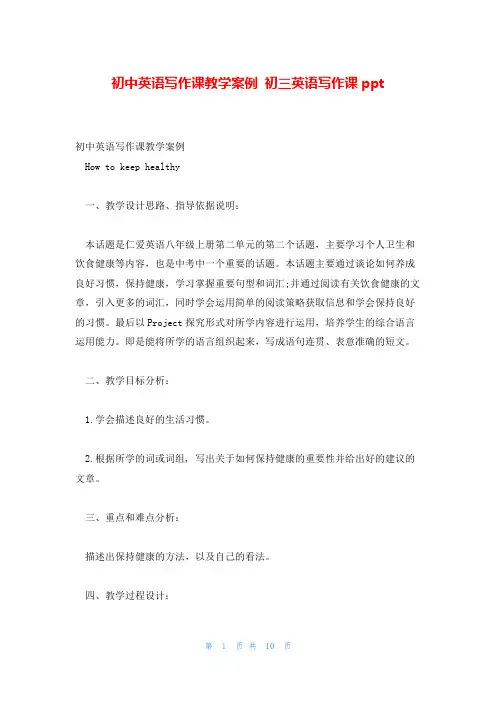
初中英语写作课教学案例初三英语写作课ppt初中英语写作课教学案例How to keep healthy一、教学设计思路、指导依据说明:本话题是仁爱英语八年级上册第二单元的第二个话题,主要学习个人卫生和饮食健康等内容,也是中考中一个重要的话题。
本话题主要通过谈论如何养成良好习惯,保持健康,学习掌握重要句型和词汇;并通过阅读有关饮食健康的文章,引入更多的词汇,同时学会运用简单的阅读策略获取信息和学会保持良好的习惯。
最后以Project探究形式对所学内容进行运用,培养学生的综合语言运用能力。
即是能将所学的语言组织起来,写成语句连贯、表意准确的短文。
二、教学目标分析:1.学会描述良好的生活习惯。
2.根据所学的词或词组, 写出关于如何保持健康的重要性并给出好的建议的文章。
三、重点和难点分析:描述出保持健康的方法,以及自己的看法。
四、教学过程设计:Step 1. Lead in: 通过讨论下面的问题,引出本节课的大任务。
吸引学生,激发其学习兴趣,提高学生作为学习主体课堂参与意识。
列一个目录在黑板1. How often do you exercise ?2. How often do you eat vegetables?3. How often do you eat fruit ?4. How many hours do you sleep every night ?5. How often do you drink milk ?6. How often do you eat junk food ?7. How often do you drink coffee ?Step 2.Revision 让学生先以小组的形式复习section A 和section B的内容,使用大脑风暴法让学生brainstorm说出一些食物名称和healthy 有关的单词短语和句子,目的是激活学生头脑中和写作话题keep healthy 相关的东西来酝酿写作的思路,以便写作时能选择有意义的东西。
英语写作教学教案
英语写作教学教案【篇一:初三英语写作公开课课教案】初三英语写作公开课课教学设计双沙中学李育新 2011.6.2课型:专题复习课教学内容:初三英语书面表达专题复习教学目标: 1.指导学生掌握书面表达语篇结构的组织技巧。
2.帮助学生学会使用常用的连接词、过渡词和过渡句,提高文章的连贯性。
3.培养学生在有限的时间内快速构思、罗列提纲的能力。
4. 指导学生小组合作评改学生习作。
教学重点: 1.帮助学生学会使用常用的连接词、过渡词和过渡句,提高文章的连贯性。
2. 培养学生在有限的时间内快速构思、罗列提纲及扩展成文的能力教学难点:1.帮助学生学会使用常用的连接词、过渡词和过渡句,提高文章的连贯性。
2. 培养学生在有限的时间内快速构思、罗列提纲及扩展成文的能力讨论法教学方法:自主学习,合作学习教学辅助手段:电脑(或实物投影仪)学情分析:1. 书面表达是写的一种途径,是英语交际的重要组成部分。
初中阶段对于英语写作的要求,实际上是“有指导的写作”(guided writing)。
它通过提供情景(文字、图画、表格),让学生用学过的英语语言来描述事物或事件并表达一定的思想,以此达成和检验对所学英语语言知识的实践应用能力。
客观地说,书面表达一直是我们英语教学的一个难点,也是学生应试的一个难点。
从中考英语试卷的抽样调查情况来看,英语写作是得分最为薄弱的一个题项。
究其原因,一是学生写作练习的时间少,二是教师平时缺乏对学生进行系统的写作知识的指导。
(比如,如何用词、句、组段、谋篇等)。
这些原因造成了学生从最初不会写盲目写到不愿写。
惧怕写,直至最后拒绝写的恶性循环。
2. 学生分析我校学生生源较差,学生英语学习两级分化严重,因此尽管经过3年的学习与训练,仍有相当一部分学生作文得分在6-7分之间甚至更低。
书面表达中式英语较多,连贯性较差。
很多学生对书面表达中快速构思和罗列提纲能力较差。
本堂课希望通过指导、帮助提高学生学会使用常用的连接词、过渡词和过渡句,提高文章的连贯性,帮助学生在有限的时间内快速构思、罗列提纲能力。
英语教案模板初中写作
英语教案模板初中写作1. 教学目标:让学生掌握一定的写作技巧,提高他们的英语写作能力。
2. 教学内容:介绍一种有效的教学方法,通过课堂实践和课后作业,帮助学生提高英语写作水平。
3. 教学过程:步骤1:课堂导入(5分钟)教师简要介绍本节课的教学目标和内容,激发学生的学习兴趣。
步骤2:写作技巧讲解(15分钟)教师讲解一些基本的写作技巧,如如何构思、如何组织文章结构、如何使用恰当的词汇和句型等。
步骤3:课堂实践(20分钟)教师给出一个写作话题,学生现场进行写作练习。
教师在课堂中巡视,为学生提供个别指导。
步骤4:作文展示与评价(15分钟)学生展示自己的作文,其他学生对其进行评价,教师进行总结性评价。
步骤5:课后作业布置(5分钟)教师布置一道课后作文题目,要求学生在课后完成。
4. 教学方法:采用讲解、实践、展示和评价相结合的教学方法,让学生在课堂实践中掌握写作技巧,提高写作能力。
5. 教学评价:通过课后作业和课堂实践,评价学生的写作能力提高情况。
6. 教学反思:教师在课后对自己的教学进行反思,看看是否达到了教学目标,有哪些优点和不足,以便在今后的教学中进行改进。
7. 教学资源:教师准备相关的写作技巧资料,如范文、写作指导等,以便在课堂上进行讲解和示范。
8. 教学时间:一节课(45分钟)9. 教学对象:初中生10. 教学重点:让学生掌握一定的写作技巧,提高他们的英语写作能力。
11. 教学难点:如何引导学生运用所学的写作技巧进行实际写作。
通过以上教案,教师可以有效地提高学生的英语写作能力,让学生在课堂实践中掌握写作技巧,提高他们的英语水平。
英语教学案例范文10篇
英语教学案例范文10篇英语教学案例是英语教师在进行教学活动中的重要参考资料。
以下是我精选的10篇英语教学案例范文,涵盖了不同年级、不同教学目标和不同教学方法的内容。
希望这些案例能为您提供一些灵感和启示。
案例一:《小学英语词汇教学——以"水果"为例》教学目标:帮助学生掌握水果类单词,并能运用目标词汇进行简单对话。
教学过程:1.引入话题,展示水果图片。
2.教学水果类单词。
3.设计小组活动,让学生用目标词汇进行交流。
案例二:《初中英语语法教学——以"一般现在时"为例》教学目标:使学生掌握一般现在时的用法,并能运用该时态描述日常生活。
教学过程:1.讲解一般现在时的概念。
2.设计练习题,巩固语法知识。
3.创设情境,让学生用一般现在时进行口语练习。
案例三:《高中英语阅读教学——以"环保"为主题》教学目标:提高学生的阅读理解能力,培养环保意识。
教学过程:1.预习课文,了解环保知识。
2.分析文章结构,讲解阅读技巧。
3.组织讨论,让学生分享自己的环保观点。
案例四:《英语听力教学——以"问路"为例》教学目标:提高学生的英语听力水平,掌握问路的表达方式。
教学过程:1.播放听力材料,让学生听懂并复述对话内容。
2.教授问路的常用表达。
3.设计角色扮演活动,巩固所学知识。
教学目标:培养学生的英语写作能力,学会用英语记录生活。
教学过程:1.讲解日记的格式和写作技巧。
2.提供写作素材,指导学生进行创作。
3.互相批改,提高写作质量。
案例六:《英语口语教学——以"旅游"为例》教学目标:提高学生的英语口语水平,学会用英语描述旅游景点。
教学过程:1.展示旅游景点图片,引导学生用英语进行描述。
2.教授相关表达,如:询问景点信息、推荐旅游景点等。
3.组织口语交流,让学生互相分享旅游经历。
案例七:《英语课堂教学游戏设计——以"猜词游戏"为例》教学目标:激发学生学习英语的兴趣,提高课堂参与度。
初中英语阅读与写作教学案例
初中英语阅读与写作教学案例一、背景知识介绍初中英语考试中书面表达是对学生英语水平进行全面考核的综合测试。
它不仅考查考生的词汇、语法等语言知识,还测评考生的分析思考能力、文字组织能力以及语言表达能力等。
初中阶段对于英语写作的要求,实际上是”有指导的写作”(guided writing)。
它通过提供情景(文字、图画、表格),让学生用学过的英语语言来描述事物或事件并表达一定的思想,以此达成和检验对所学英语语言知识的实践应用能力。
九年级的学生对中考的书面表达,有不同的感受。
几年的英语学习下来,能否学以致用?将积累丰富的语言材料运用到表达自己思想的写作中?相当一部分孩子还是很有惧意。
这其中:1.汉语式的语句2.文章的流畅程度3.句式的单一都极大的影响孩子们的写作成绩。
课标要求培养学生的读写技能,”读”为输入,写为输出,读为”写”服务,也就是输入为输出服务,”写”建立在”读”的基础之上。
利用课文的内容和篇章结构进行写作训练,使学生通过阅读获取信息,进而在写作活动中有效输出信息。
基于以上的思考,我设计了这堂语篇复习与书面表达课。
二、教学课例我选取的是《初中英语中考说明与指导》第四章日常活动这个话题,为了实现学生能够由阅读文本信息到准确表达自己的日常活动而进行的阅读和写作课的尝试和探索。
教学目标:1.通过对课文的阅读和分析,学生能:掌握谈论日常活动的短语和句型。
掌握语篇的结构,关注语篇的常用时态,并合理运用关联词。
2.运用本节课所复习的短语、句型及语篇结构,完成写作任务”描写自己和家人的日常活动”。
教学设计1、总体思路在教学中,我选取了教材中与日常活动相关的两篇阅读文章作为阅读材料,让学生了解文章的时态、句子与句子之间的逻辑关系,引导学生在阅读文章时分析其语言、体裁、内容和语篇结构,引导学生理解写作的意图与目的,抓住主题句,理解细节与主题之间的关系,帮助学生掌握写作的基本框架和技巧。
2、教学过程step 1 revision ①使用头脑风暴法(brainstorm)让学生想出一些和日常活动有关的单词短语,目的是激活学生头脑中和写作话题daily activities 相关的知识,并把它们分成生活起居、家务学习和课余生活三个方面。
- 1、下载文档前请自行甄别文档内容的完整性,平台不提供额外的编辑、内容补充、找答案等附加服务。
- 2、"仅部分预览"的文档,不可在线预览部分如存在完整性等问题,可反馈申请退款(可完整预览的文档不适用该条件!)。
- 3、如文档侵犯您的权益,请联系客服反馈,我们会尽快为您处理(人工客服工作时间:9:00-18:30)。
中考英语书面表达—记叙文案例
一.思考的问题
1、如何在课堂上充分调动学生学习的积极性?
2、设计何种任务提高学生的英语写作能力?
3、怎样培养学生的合作学习精神?
二.案例描述
一)背景
书面表达是通过文字传递信息和表达思想的一种交际活动。
书面表达试题比较注重考查学生在特定情境里综合运用语言进行表达的能力。
初中阶段对于英语写作的要求,实际上是“有指导的写作”(Guided Writing)。
它通过提供情景(文字、图画、表格),让学生用学过的英语语言来描述事物或事件并表达一定的思想,以此达成和检验对所学英语语言知识的实践应用能力。
客观地说,书面表达一直是我们英语教学的一个难点,也是学生应试的一个难点。
尚老师为了促进英语教学,特别组织书面表达研讨课。
二)课前准备
我们认真备课,充分利用和开发英语课程资源。
采用任务型的教学途径,争取为专项复习研讨提供一堂成功的课。
教学媒体的选择和运用:CAI课件、实物展台等。
多媒体课件的采用,使知识的呈现趣味、生动,提高教学质量和学习效率。
三)教学目标:
1.通过对两篇中考真题范文的分析,使学生了解书面表达的考查内容和写记叙文的要点。
2.让学生归纳总结出书面表达的写作技巧,提高写作的水平,更好的应对中考。
四)教学过程
第一步,引入
通过让学生猜“What’s my hobby?”引出主题“中考英语书面表达——记叙文”。
这一步充分引起了学生的兴趣,调动了学生的积极性。
第二步,开门见山,直入主题。
屏幕上出现2007年山东省中考试题,接着问学生一些问题:假如让你写的话,你应该用第几人称、什么时态、什么顺序?学生回答完后,接着屏幕下面出现什么情况下用第几人称,什么情况下用什么时态。
这一环节选材贴近学生,所问问题正是学生看到作文题目后所应该确定的问题,所以启发了学生的思维,调动了学生的积极性,同时也教会了他们审题的方法。
接着屏幕上出现了2007年的中考试题范文,让学生说出这篇文章写得怎么样,“你最喜欢的句子是什么”,这样就引导学生细读范文,分析句式,调动了学生的积极性。
然后屏幕上出现使用这些恰当的连接词,可以让线索更清晰,表达更流畅。
灵活运用长短句,使文章呈现出句式的多样性和语言的丰富性,教会了学生一些写作技巧。
第三步,屏幕上出现2007年济宁市中考书面表达的范文,让学生分析这篇文章的文体、人称、时态和连接词,启发了学生的思维。
然后设计任务让学生猜教师最喜爱的哪一句,引起了学生的兴趣,同时也激活了课堂气氛,当学生猜出
最后一句感叹句时,然后接着问“这句话在整个文章中呈现出什么样的效果呢”,当屏幕上出现了锦上添花的效果时,本节课达到了高潮。
在这一环节中选材贴近学生,充分了解学生的认知规律,让学生在教师的帮助下潜移默化地学习知识,不是教师讲,而是启发学生说,充分调动了学生的主动性和积极性,启发了学生的思维。
第四步,如果说中考真题范文的分析是输入的过程,那么写作就是输出的过程,在这一环节中,首先让学生审题。
然后分组讨论四幅图画的内容,并用短语的形式做报告。
在这一环节中,组织学生在小组活动中共同完成教师布置的任务,从而降低其难度,使基础好的同学在写作时起点更高,基础较差的同学也能言之有物,互相启发,让所有参加者在自由、愉快、畅所欲言的气氛中自由交换观点,并以此诱发集体智慧。
通过小组活动使学生感受到合作学习的成功。
但是知识转化为技能是要靠练习的,所以在下一环节中给学生充分的时间进行写作,然后提供写作标准点评两篇学生习作,选自一位基础较好的同学和一位基础一般的同学的作文。
教师根据上述提供的写作标准,详细点评两篇习作的篇章结构和句法功能。
目的是使学生尽力领会教师对文章的点评,培养学生选词和用词的能力,指导学生多模仿好文章的优点。
然后提供范文让学生修改自己的作文,通过自改使学生提高表达的准确性,提高了学生通过自己独立思考解决问题的能力。
在这一环节中,教学过程注重让学生收集信息,然后活学活用信息。
第五步,突出学生主体,教学活动围绕学生展开。
让学生谈体会,归纳总结出书面表达的写作步骤与技巧。
这节课主要是通过对两篇中考真题范文的分析,让学生了解中考书面表达的考查内容和写记叙文的要点。
归纳出书面表达的写作技巧。
教学过程注重让学生提取信息,在获取信息的同时加工整理信息,充分调动了学生的积极性和主动性。
三、本堂课中的精彩片段。
使用brainstorming培养学生在英语写作中自主学习的能力。
Brainstorm ing 这种外语教学中常用的教学技巧可直评为“头脑风暴法”是一种通过小组活动,让所有参加者在自由、愉快、畅所欲言的气氛中自由交换观点,并以此诱发集体智慧,激发学习者创意与灵感的学习方法。
在英语课中的 prewriting阶段,使用brainstorming对促进学生的自主学习,发展学生写的能力起着积极的促进作用。
四.反思评价
通过对中考英语书面——记叙文的学习,让学生从思想上不再畏惧写作文了,改变了一部分学生看到作文就想放弃的念头,一方面使他们的审题的能力增强了,另一方面,他们能按中考英语评分标准要求自己,句式不再都是简单句。
为了使文章具有层次性,他们使用了恰当的连接词。
为了使文章呈现出句式的多样性和语言的丰富性,他们使用了一些含有高级词汇的句式,同时他们还注意到卷面的整洁性。
总之,通过这节课的学习,确实使学生掌握了一定的写作技巧,提高了他们的写作水平。
